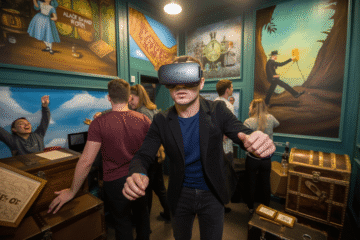What is Structure in Art?
Structure in art refers to the way elements are organized and arranged within a composition to create a cohesive and meaningful whole. It’s the framework that holds a piece together, guiding the viewer’s eye and conveying the artist’s intent. Think of it as the skeleton of a painting, sculpture, or any creative work—whether it’s the balanced composition of a landscape painting or the rhythmic repetition in a textile design. Structure provides order, harmony, and purpose, ensuring that every line, shape, or color serves the artwork’s narrative or emotional impact.
In its simplest form, structure is about relationships: how shapes interact, how colors contrast, or how lines lead the viewer through the piece. For example, in a painting, structure might be the way the artist divides the canvas into foreground and background or uses symmetry to create balance. In Gloucester, with its rich artistic heritage—from the intricate stonework of Gloucester Cathedral to the vibrant murals in the city’s streets—structure is everywhere, shaping how we experience art in our daily lives.
A Deep Dive into Structure in Art
The Foundations of Structure
At its core, structure in art is about creating order from chaos. Artists use principles like balance, contrast, rhythm, and proportion to organize visual elements. These principles, often referred to as the “elements and principles of design,” are universal, whether you’re looking at a medieval stained-glass window in Gloucester Cathedral or a modern installation at the Gloucester Guildhall.
- Balance: This can be symmetrical, like the mirrored arches in the cathedral’s cloisters, or asymmetrical, like a contemporary sculpture that feels weighted yet harmonious. Balance ensures the artwork doesn’t feel chaotic or lopsided.
- Contrast: Artists use differences in color, texture, or shape to create focal points. For instance, a Gloucester artist might contrast the gritty texture of the city’s docks with the smooth sky in a watercolor painting.
- Rhythm: Repetition of shapes or lines creates movement. Think of the repeating patterns in the Arts and Crafts textiles inspired by William Morris, whose influence is still felt in Gloucestershire’s creative scene.
- Proportion: This governs the size relationships between elements. A local sculptor might exaggerate the scale of a ship’s prow in a piece inspired by Gloucester’s maritime history to evoke grandeur.
Structure in Gloucester’s Artistic Context
Gloucester’s art scene offers a unique lens to explore structure. The city’s history, from its Roman origins to its industrial past, informs how local artists approach composition. Take Gloucester Cathedral, a masterpiece of Gothic architecture. Its structure is not just physical but visual: the soaring vertical lines of the nave draw the eye upward, creating a sense of awe. The stained-glass windows, with their carefully arranged panels, use geometric structure to tell stories of faith and history. This deliberate organization of space and narrative is a perfect example of structure in art.
Local artists today continue this tradition. At galleries like the Gloucester City Museum and Art Gallery, you’ll see works that reflect the city’s blend of heritage and modernity. For instance, a contemporary painting might use the grid-like structure of Gloucester’s Roman street layout as a compositional framework, with intersecting lines guiding the viewer through a depiction of the city’s docks or countryside.
Real-Life Examples of Structure in Art in Gloucester
The following table highlights real-life examples of structure in art, drawing from Gloucester’s rich artistic landscape. Each example illustrates how artists or architects have used structural principles to create impactful works.
| Artwork/Location | Medium | Structural Principle | Description |
|---|---|---|---|
| Gloucester Cathedral’s Stained-Glass Windows | Stained Glass | Symmetry and Rhythm | The cathedral’s Great East Window uses a symmetrical grid of panels to tell biblical stories, with repeating geometric shapes creating a rhythmic flow that guides the viewer’s eye across the narrative scenes. |
| Gloucester Docks by John Atkinson Grimshaw (Museum of Gloucester) | Painting | Rule of Thirds and Contrast | This painting uses the rule of thirds to place the docks’ masts and buildings, with strong contrasts between the dark water and illuminated sky to create a balanced yet dynamic composition. |
| Street Murals in Barton | Street Art | Asymmetrical Balance | Murals in Barton, like those on High Street, use bold, asymmetrical designs with vibrant colors and geometric shapes to create visual interest, balancing chaos with structured focal points. |
| Sculptures in Kings Square | Sculpture | Proportion and Negative Space | Public sculptures, such as those installed during Gloucester’s regeneration projects, use exaggerated proportions and carefully planned negative space to engage viewers from multiple angles, creating a sense of harmony. |
| Arts and Crafts Textiles at Nature in Art | Textile | Repetition and Pattern | Exhibitions at Nature in Art feature textiles inspired by William Morris, using repeating floral motifs to create rhythm and unity, reflecting Gloucestershire’s Arts and Crafts heritage. |
These examples, sourced from local institutions like the Museum of Gloucester and Nature in Art, as well as public spaces, show how structure is woven into Gloucester’s artistic identity.
The Role of Structure in Art in Different Mediums
Structure in art manifests differently across artistic mediums, and Gloucester’s diverse creative community showcases this variety:
- Painting and Drawing: In a landscape painting of the Severn Estuary, an artist might use the rule of thirds—a structural principle dividing the canvas into a 3×3 grid—to place the horizon or a focal point like a lone boat. This creates balance and draws attention to key elements.
- Sculpture: Consider a sculpture in Kings Square. Its structure might rely on physical balance (to stand upright) and visual balance (to engage viewers from all angles). The interplay of form and negative space is critical.
- Textiles and Crafts: Gloucestershire’s Arts and Crafts legacy, inspired by figures like Morris, emphasizes structured patterns. A local weaver might use repeating motifs inspired by the Cotswolds’ rolling hills, creating rhythm and unity.
- Street Art: Gloucester’s street art, like the murals in Barton, often uses bold lines and geometric shapes to structure vibrant, chaotic designs. The structure here is less formal but still guides the viewer’s experience.
The Psychology of Structure
Structure isn’t just about aesthetics; it’s about how we perceive and process art. Humans naturally seek patterns and order, and artists exploit this to create emotional impact. A tightly structured piece, like a symmetrical mandala, can evoke calm, while a deliberately chaotic structure, like an abstract expressionist painting, might provoke unease. In Gloucester, where community and history are deeply felt, artists often use structure to connect viewers to place. A painting of the docks might use converging lines to mimic the shape of a ship’s hull, evoking nostalgia for the city’s maritime past.
Structure in Contemporary Art
Modern artists in Gloucester and beyond are pushing the boundaries of structure. Some reject traditional frameworks, like the grid or golden ratio, in favor of organic, fluid compositions. Others use digital tools to create complex, algorithmic structures that challenge the viewer’s perception. At events like the Gloucester Open Art Exhibition, you’ll see this experimentation firsthand—artists blending structured compositions with spontaneous, expressive elements.
For example, a local digital artist might use software to generate a fractal-like structure inspired by the Severn’s tidal patterns, creating a piece that feels both ordered and unpredictable. This reflects a broader trend: structure in contemporary art often balances control and freedom, mirroring the tension between Gloucester’s historic roots and its evolving identity.
Why Structure Matters
Structure is the unsung hero of art. Without it, even the most vibrant colors or bold ideas can feel disjointed. It’s what makes a piece memorable, whether it’s a cathedral window that’s stood for centuries or a street mural painted last week. In Gloucester, where art is woven into the city’s fabric—from the sculptures along the docks to the exhibitions at Eastgate Gallery—structure helps artists tell stories that resonate with locals and visitors alike.
For aspiring artists in Gloucester, understanding structure is key. Visit local landmarks like the cathedral or the docks, sketch their forms, and notice how lines, shapes, and spaces work together. Experiment with balance and rhythm in your own work, whether you’re painting, sculpting, or designing. Structure isn’t a rulebook—it’s a tool to amplify your voice.
Structure in Art – The Invisible Force That Shapes Art
Structure in art is the invisible force that shapes how we see and feel. From the Gothic arches of Gloucester Cathedral to the dynamic murals in the city’s streets, structure is everywhere, organizing chaos into meaning. By studying and experimenting with structure, artists in Gloucester and beyond can create works that are not only beautiful but deeply connected to the world around them. So next time you’re wandering through Gloucester’s historic streets, look closely at the art—its structure is telling you a story.


